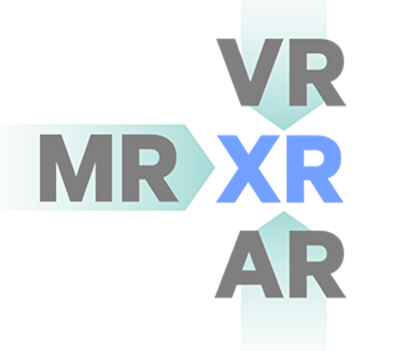AI And XR Convergence: Key Platforms And Market Opportunities

Table of Contents
Key Platforms Driving AI and XR Convergence
The synergy between AI and XR is fueled by several key platforms, each playing a crucial role in accelerating development and deployment of innovative applications.
AI-Powered XR Development Platforms
These platforms significantly streamline the creation of intelligent XR applications, reducing development time and enhancing the overall quality of the final product. They integrate AI capabilities directly into the development workflow, allowing developers to easily incorporate features like AI-driven character animation, realistic physics simulations, and personalized user experiences.
- Example platforms: Unity with ML-Agents, Unreal Engine with its suite of AI features, specialized AI SDKs (Software Development Kits) for XR development such as those offered by leading AI companies. These SDKs often provide pre-built AI models and tools, further simplifying the development process.
- Benefits: Reduced development time and costs, enhanced realism and immersion, improved user experience through AI-driven personalization and adaptive gameplay, and the ability to create more complex and dynamic XR environments.
- Market Opportunity: The growing demand for efficient and powerful development tools fuels significant market growth for these platforms. As the XR market expands, so too will the demand for platforms that can handle the increasing complexity of AI-powered XR applications. This presents a lucrative opportunity for both established and emerging technology companies.
Cloud-Based AI for XR
Cloud computing is proving essential for powering the computationally intensive AI tasks required for many complex XR applications. Cloud-based solutions offer scalability and accessibility, enabling developers to leverage powerful AI models without needing significant on-premise infrastructure.
- Example services: Amazon Web Services (AWS), Google Cloud Platform (GCP), and Microsoft Azure all offer robust AI services seamlessly integrated with XR development tools. These services provide access to powerful GPUs (Graphics Processing Units) and TPUs (Tensor Processing Units) for training and deploying AI models.
- Benefits: Handles computationally intensive AI tasks in real-time, enables seamless scalability to accommodate growing user bases, facilitates collaborative development and deployment across geographically dispersed teams, and reduces the upfront investment required for developers.
- Market Opportunity: The increasing adoption of cloud computing and AI services directly boosts the demand for cloud-based XR solutions. As businesses seek more scalable and cost-effective ways to develop and deploy AI-powered XR experiences, the cloud will play an increasingly vital role.
AI-Enhanced XR Hardware
The development of new XR hardware incorporating AI capabilities directly into the devices is another major driver of this convergence. This allows for more responsive, immersive, and intuitive XR experiences.
- Examples: Headsets with integrated AI processors for improved tracking and rendering, leading to smoother and more realistic experiences. Smart glasses with AI-powered object recognition that can provide users with real-time information about their surroundings. Haptic suits enhanced with AI to provide more realistic and nuanced feedback.
- Benefits: More realistic and responsive XR experiences, improved user comfort and convenience through features such as intuitive gesture recognition and adaptive rendering, and the potential for entirely new types of interactive experiences.
- Market Opportunity: Innovation in hardware is crucial for driving the adoption of more sophisticated and immersive XR applications. The market for AI-enhanced XR hardware is poised for significant growth as technology continues to advance.
Market Opportunities in AI and XR Convergence
The combination of AI and XR creates a vast landscape of market opportunities across multiple sectors.
Gaming and Entertainment
AI is transforming gaming and entertainment by creating more immersive and engaging experiences.
- Examples: AI-powered Non-Player Characters (NPCs) exhibiting realistic and unpredictable behaviors, procedurally generated game worlds that offer endless replayability, and personalized gameplay experiences tailored to individual player preferences.
- Market Opportunity: The potential for growth is enormous. Enhanced realism and personalization will drive increased player engagement and spending, leading to significant revenue growth for game developers and publishers.
Training and Education
AI and XR offer revolutionary approaches to training and education.
- Examples: VR surgical simulators allowing medical students to practice complex procedures, AR training for manufacturing workers to learn assembly processes, and immersive historical recreations for educational purposes.
- Market Opportunity: The growing need for effective and engaging training solutions across various industries is driving significant demand for AI-powered XR training platforms.
Healthcare
AI and XR are poised to revolutionize healthcare.
- Examples: AR-assisted surgery improving precision and accuracy, VR therapy for PTSD and other mental health conditions, and AI-powered medical image analysis improving diagnostic accuracy and speed.
- Market Opportunity: The potential for improving healthcare outcomes and efficiency is enormous, creating significant market opportunities for companies developing AI and XR solutions for the healthcare sector.
Retail and E-commerce
AI and XR enhance the customer experience in retail and e-commerce.
- Examples: Virtual fitting rooms allowing customers to try on clothes virtually, AR product visualization in furniture stores, and AI-powered chatbots providing personalized customer service.
- Market Opportunity: Increased customer engagement and conversion rates drive adoption across retail and e-commerce sectors, leading to significant revenue growth for businesses that leverage AI and XR effectively.
Conclusion
The convergence of AI and XR is revolutionizing industries and creating substantial market opportunities. By leveraging AI-powered development platforms, cloud-based services, and advanced hardware, businesses can develop innovative applications across various sectors. From gaming and entertainment to healthcare and retail, the potential for growth in the AI and XR Convergence market is immense. To capitalize on these opportunities, businesses need to explore the key platforms discussed and invest in research and development to create groundbreaking and user-friendly applications. Don't miss out on the exciting possibilities of AI and XR Convergence; start exploring the potential today!

Featured Posts
-
 Last Seals Released As Pieterburen Seal Rescue Center Closes Its Doors
May 13, 2025
Last Seals Released As Pieterburen Seal Rescue Center Closes Its Doors
May 13, 2025 -
 Ademola Lookman Transfer Liverpool Face Chelsea Competition
May 13, 2025
Ademola Lookman Transfer Liverpool Face Chelsea Competition
May 13, 2025 -
 Eva Longoria Sizzles In A Tiny Leopard Bikini
May 13, 2025
Eva Longoria Sizzles In A Tiny Leopard Bikini
May 13, 2025 -
 Serie A Cuando Y Donde Ver El Partido Ac Milan Vs Atalanta Gimenez
May 13, 2025
Serie A Cuando Y Donde Ver El Partido Ac Milan Vs Atalanta Gimenez
May 13, 2025 -
 Ostapenko Upsets Sabalenka In Stuttgart Final
May 13, 2025
Ostapenko Upsets Sabalenka In Stuttgart Final
May 13, 2025
